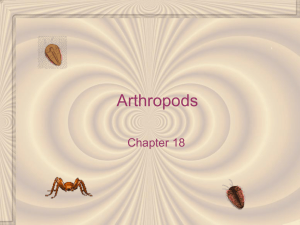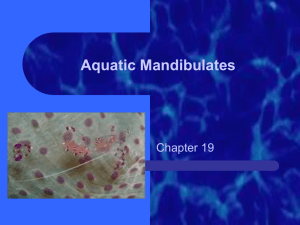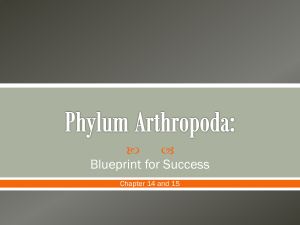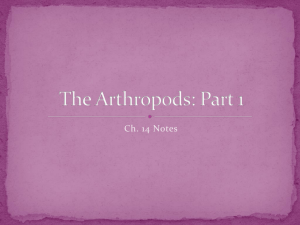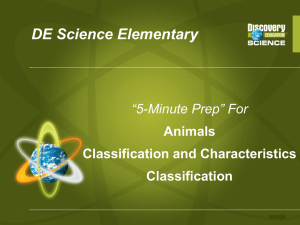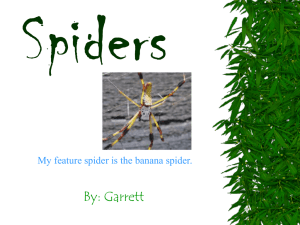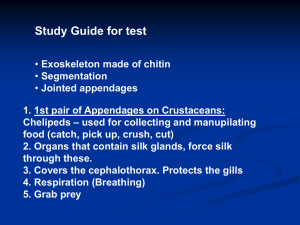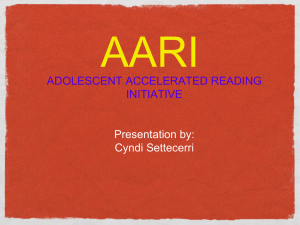Hickman Chapter 13 Final PPT
advertisement
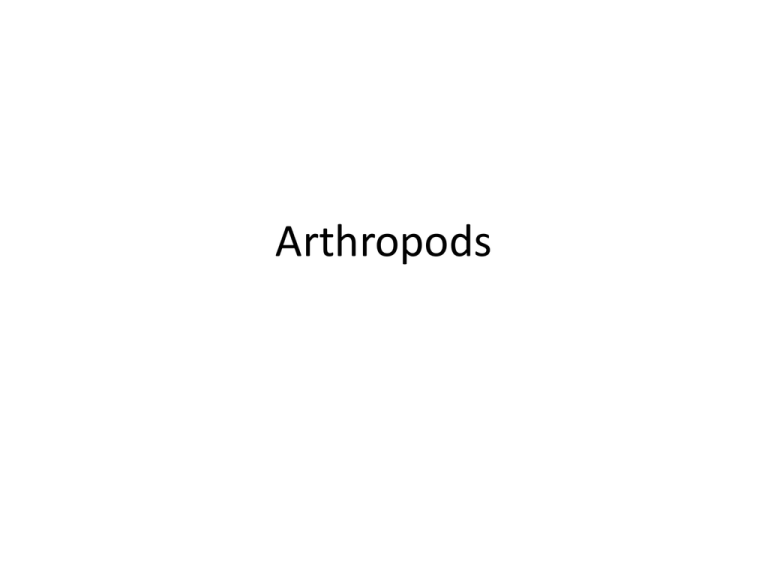
Arthropods Insects were a winning combination • Insects cause hugh economic losses (but a lot of benefits, as well) each year • They are the dominant group of animals on the earth today • The diversity of insects is far greater than all other taxa combined • There are an estimated 200 million insects alive for every human today Characteristics of Arthropoda • Arthropods includes spiders, scorpions, ticks, mites, crustaceans, millipedes, centipedes, insects, and some smaller groups as well • There is a rich fossil record extending back to the mid-Cambrian period Characteristics • Arthropods have a well-developed organ system and a chintinized cuticular exoskeleton • Segments have coalesced into tagmata • They range in size from .1 mm to 13 feet! • Arthropods compete with us for food and spread disease; they also produce silk, honey, and beeswax Ecological Relationships • They are found in all environments and virtually all altitudes and latitudes • Species are adapted to land and to fresh, brackish, and marine water • Most species fly to their favored habitats • All modes of feeding occur among arthropods though the majority are herbivorous • Nothing else matches their divesity Characteristics of the arthropoda • An exoskeleton with a cuticle that is highly protective but is jointed, providing mobility • Both layers of the cuticle contain chitin bound with protein • Chitin is a tough resistant polysaccharide insoluble in water Characteristics of the arthropoda • Terrestrial arthropods use an efficient tracheal system that delivers oxygen directly to cells • Aquatic arthropods respire by various forms of efficient gills • Arthropods have highly developed sensory organs – Sensory organs vary from a compound mosaic eye to other senses of touch, smell, hearing, balancing and chemical reception Segmentation and Appendages • Each segment usually has a pair of jointed appendages • Segments and appendages are modified for various adaptive functions • Appendages may function in sensing, food handling, walking or swimming Characteristics of the arthropoda • As the cuticle is thin between segments, it allows movement at the joints • Muscles attach to the cuticle • The cuticle also folds inward to line the foregut, hindgut, and the trachea • Ecdysis, or molting, is the process of shedding its outer exoskeleton • Arthropods usually molt 4 to 7 times; the weight of the exoskeleton limits their body size Taxonomy of the arthropods • There are four subphyla: – Trilobita – Chelicerata – Crustacea – Uniramia Subphylum Trilobita • Trilobita arose before the Cambrian, flourished, and then became extinct 250 million years ago • They have a trilobed body shape due to a pair of longitudinal grooves • They were bottom dwellers and probably were scavengers • They ranged from an inch to 20 inches or more and could roll up like pill bugs Subphylum Chelicerata • Include the horseshoe crabs, spiders, ticks, mites, scorpions, and sea spiders • Chelicerates have six pairs of appendages including chelicerae, pedipalps and four pair of legs • They lack mandibles and antennae • Most suck liquid food from prey Class Merostomata • Includes the modern horeshoe crab; Limulus polyphemus • This species is nearly unchanged from its Cambrian ancestors • Five species in three genera survive The Horseshoe Crab • Most live in shallow water • They have an unsegmented carapace that covers the body in front of a broad abdomen • A telson or spinelike tail • Book gills are exposed on some of the abdominal appendages • They walk with their walking legs and swim with abdominal plates • They feed at night on worms and small molluscs Class Pycnogonida the sea spiders • They vary from a few millimeters to centimeters; all have small, thin bodies • Some males use legs to carry developing eggs • The mouth at the tip of a proboscis, drinks juices from cnidarians (hydroids) and soft-bodied animals • They have a greatly reduced abdomen attached to an elongated cephalothorax Class Arachnida • Consists of a great diversity among scorpions, mites, ticks, daddy longlegs and others • Of 80,000 species, most are free living and more common in warm, dry regions • Arachnids are dived into a cephalothorax and abdomen Order Araneae the spiders • About 40,000 species of spiders are known • The body consists of an unsegmented cephalothorax and abdomen joined by a slender pedicel Order Araneae the spiders • The anterior appendages are a pair of chelicerae with terminal fangs • All spiders are predaceous, mostly on insects, which are killed b poison and fangs • The injected venom liquefies and digests the tissues which are then sucked into the spider’s stomach • Spiders breath by book lungs and/or trachae Characteristics of the spiders • Book lungs are found only in the spiders; parallel air pockets extend into a blood-filled chamber • Air enters the chamber through a slit in the body wall • The tracheae system is less extensive than in insects; it carries air directly to tissues • Spiracles are openings to the trachea • Most spiders have eight simple eyes, each with a lens, optic rods and a retina • They detect movement and may for images • Sensory setae detect air currents, web vibrations, and other stimuli Web-spinning Habits • Spinning silk is a critical ability for spiders and some other arachnids • Two or three pairs of spinnerets contain microscopic tubes that run to silk glands • A liquid protein secretion hardens as it is extruded from the spinnerets • Silk threads are very strong and will stretch considerably before breaking • Spiders are often camouflaged or cryptic Web-spinning Habits • Jumping spiders (Salticidae) have excellent vision and stalk their prey • Silk is used for orb webs, lining burrows, forming egg sacs, and wrapping prey • Wolf spiders, jumping spiders, and fisher spiders chase and catch their prey Spider Diversity Reproduction in spiders • Males court females before mating • The male spins a small web, deposits a drop of sperm on it, and then stores the package in his pedipalp • Mating involves inserting the pedipalps into the female genital openings and depositing the spermatophore • Sperm are stored in a seminal receptacle for weeks or months until the eggs are ready • Eggs may develop in a cocoon in the web or may be carried by the female • The young hatch in a few weeks and may molt before leaving the cocoon Venomous spiders • Most are feared for no reason at all • Spiders help to control the populations of insects • American tarantulas rarely bite and the bite is not dangerous • The black widow (Lactrodectus mactans) however, can be fatal – The venom is neurotoxic • The brown recluse spider, Loxosceles recluse, has hemolytic venom that destroys tissue around the bite • Some Australian and South American Spiders are the most dangerous and aggressive Order Scorpionida: Scorpions • More common in tropical and subtropical (such as Florida!) zones but do occur in temperate areas • They are nocturnal and feed largely on insects and spiders • The short cephalothorax has the appendages and 1 to 6 pair of eyes • The postabdomen has the long slender tail of five segments that end in a stinging apparatus • Scorpions bear live young carried on the mothers back Order Opiliones: Harvestmen • Harvestmen or Daddy longlegs are common, especially in tropical areas • Unlike spiders, their abdomen and cephalothorax join broadly without a narrow pedicel • They can lose one or mor legs of their eight legs without ill effect • Their chelicerae are pincer-like and they feed more as scavengers than do spiders Order Acari: Ticks and Mites • They are medically and economically the most important arachnids • Their mouthparts are on the tip of the anterior capitulum • They are both aquatic and terrestrial; some parasitize vertebrates and invertebrates • About 40,000 species have been described; many more are estimated to exist Diversity of mites and ticks • House mites are free-living and cause allergies • Spider mites are one of the many important agricultural pest mites that suck out plant nutrients • Chiggers are larval Trombicula mites; they feed on dermal tissues and cause skin irritation • The hair follicle mite Demodex is harmless but related species cause mange in domestic animals • Ticks are usually larger than mites • Tick species of Ixodes carry Lyme disease • Tick species of Dermacentor transmit Rocky Mountain Spotted Fever • The cattle tick transmits Texas cattle fever Diversity of Mites and Ticks Subphylum Myriapoda • Includes the centipedes, millipedes, pauropods and symphylans • Several classes have two tagmata – a head and trunk with paired appendages on the trunk • Myriapods only have one pair of antennae, mandibles, and maxillae • Legs are always uniramous • Respiration occurs through the body surface, trachea, or gills in juveniles Class Chilopoda: Centipedes • Centipedes are terrestrial carnivorous predators found under logs, bark and stones eating earthworms, cockroaches and other insects • Their flattened bodies have up to 177 segments Class Chilopoda: Centipedes • Each segment, except the one behind the head and the last two, bears a pair of appendages • Appendages of the first body segment form venom claws • The head has a pair of eyes on either side of the head that consist of groups of ocelli • A pair of spiracles in each segment allows air to diffuse through branched air tubes of the trachae • The sexes ar separate; all are oviparous and the young resemble the adults • One genus of house centipede has 15 pairs of legs and another has 21 pairs • Most are harmless to humans but a few large, tropical centipedes are dangerous Class Diplopoda • Millipedes have many legs, but not a thousand as they are sometimes called • Their cylindrical bodies have from 25 to 100 segments • Two pairs of legs are present per segment, probably from the fusion of two segments • Each abdominal segment has two pair of spiracles opening into air chambers and tracheal air tubes • Most eat decayed plants but a few eat living plant tissue • After copulation, the female lays eggs in a nest and guards them • Larvae have only one pair of legs to each segment Millipedes Subpylum Crustacea • 67,000 species include lobsters, crayfish, shrimp, crabs, and copepods • Most are aquatic, and free living, many are sessile, commensal, or parasitic • The main distinguishing characteristic of crustaceans is that they have two pairs of antennae • The head also has a pair of mandibles and two pair of maxillae Typical Body Plan Subphylum Crustacea • There is one pair of appendages on each of the additional segments; some segments lack appendages • All appendages, except perhaps the first antennae, are biramous with two main branches • Primitive crustaceans may have up to 60 segments; modern crustaceans have 16-20 • The tagmata are usually head, thorax and abdomen • The dorsal covering is the carapace; it may cover most of the body or just the cephalothorax Form and Function of Crustacea • Crayfish and lobsters show modifications to their appendages • Swimmerets retain the primitive biramous condition and consist of an endopod and exopod which are attached to one or more basal segments collectively called a protopod Form and Function of Crustacea • Crayfish appendages have evolved into walking legs, mouthparts, swimmerets, etc from modification of the basic biramous appendage – The evolutionary trend is reduction and modification of appendages • Three pairs of thoracic appendages are called maxillipeds; the first pair of walking legs are called chelipeds, and the last pair of appendages are called uropods Form and Function of Crustacea • Abdominal swimmerets are used in locomotion, the first pair are named gonopods • Gonopods in males are modified for copulation; females attach eggs and young to them • Uropods serve as paddles for swift backward movement • The telson also protects eggs and young on the swimmerets External Structure of Crayfish Important Internal Features • Major body space is a blood-filled hemocoel • Muscular and nervous sysems show the metamerism of annelid-like ancestors • Most muscles are antagonistic; flexors draw a limb toward the body and extensors straighten a limb out • Abdominal flexors of a crayfish allow it to swim backward • Strong muscles located on each side of the stomach control the mandables The molting process • Molting is necessary for a crustacean to increase in size; the exoskeleton does not grow • The physiology of molting affects reproduction, behavior and many metabolic processes • Inorganic salts are withdrawn from the old cuticle during premolt • The underlying epidermis secretes the cuticle • Enzymes released into the area above the new epicuticle dissolve the old endocuticle • The animal then swallows water or air to expand and burst the old cuticle • The new soft cuticle stretches and then hardens with the deposition of inorganic salts during postmolt • Molting occurs often in young animals and may cease in adults • Temperature or day length may trigger molting Ecdysis or Molting Molting sequence of a lobster Feeding Habits • Many crustaceans shift from one type of feeding to another, depending on food availability • The same fundamental mouthparts are adapted to a wide array of food availability • Mandibles and maxillae ingest food; maxillipeds hold and crush food • Suspension feeders generate water currents in order to eat plankton, detritus and bacteria • Predators consume larvae, worms, crustaceans, snails and fishes Feeding Habits • The shrimp-like Lygiosquilla pierces prey with a specialized digit on a walking leg • The pistol shrimp Alpheus catches prey with a large chela that snaps shut • Scavengers eat dead animal and plant matter • Crayfishes have a two-part stomach; a gastric mill grinds up food in the first compartment Internal anatomy of crustaceans • Gills that vary in shape • Excretory and osmoregulatory organs are located in the head • Decapods have antennal glands called green glands • Waste products consist of ammonia with some urea and uric acid • Crustaceans and other arthropods have an open circulatory system; there is no system of veins to separate blood from interstitial fluid Internal anatomy of crustaceans • Movement of organs and limbs circulate blood in the open sinuses • Hemocyanin and hemoglobin are respiratory pigments; clotting also occurs • There is a brain with a double ventral nerve cord • A median eye and compound eyes are present • The median eye consists of three pigment cups, retinal cells, and possible a lens • Crustacean compound eyes are similar to insect eyes • Attached to moveable stalks, compound eyes detect motion and analyze polarized lights • Statocysts, tactile setae, and chemosensitive setae are also present Reproduction and Life Cycles • Crustaceans have separate sexes with specializations for copulation • Almost all barnacles are monecious but generally crossfertilize • In some ostracods, males are scarce and reproduction is by parthenogenesis • Most crustaceans brood eggs in brood chambers, in brood sacs attached to the abdomen, or attached to abdominal appendages • Crayfish develop directly without a larval form • Most crustaceans have a larva unlike the adult in form, and under metamorphis • The Nauplius is a common larval form Life Cycle of Gulf Shrimp Brief Survey of Crustaceans • Ostracods are enclosed in a bivalve carapace and resemble tiny clams and are less than 1/16 inch long • Most live in marine or freshwater sediments but some scavenge or feed on detritus • Copepods have numerous species • They lack a carapace and retain the simple, median eye in the adult • They have four pairs of flattened, biramous, thoracic swimming appendages • Free-living copepods may be the dominant primary consumer in aquatic communities • Parasitic forms are highly modified and reduced, often unrecognizable as arthropods • Brachiurans lack gills and most are parasites of fish • Found on both marine and freshlwater fish Cirripedia – the barnacles • Barnacles as adults are sessile and attach directly or by a stalk to the substrate • The carapace surrounds the body and secretes a set of calcareous plates • The head is reduced, the abdomen is absent and the thoracic legs are long with hair-like setae • The many-jointed cirri that bear the setae are extended from the plates to feed on small particles The barnacle • Isopods are dorsoventrally flattened, lack a carapace and have sessile compound eyes • The abdominal appendages bear gills • Common land forms include the sow bugs and pill bugs • Some isopods are highly modified as parasites of fish or crustaceans • Amphipods resemble isopods except they are somewhat compressed laterally • They lack a carapace and have sessile compound eyes • Many are marine, others are beach-dwelling, freshwater or parasitic • Euphausiacids or “Krill” has only 90 species but includes the important ocean plankton called krill • They form a major component of the diet of baleen whales and of many fishes. • Some are over 2 inches long • Decapods have five pairs of walking legs, the first forming pincers or chelae • They range from a few millimeters to the larges arthropod, a Japanese crab with a 12 foot legspan • They are true crabs with a broader cephalothorax and reduce abdomen, compared to crayfish or lobsters • Fiddler crabs have a reduced abdomen and burrow in the sand • Hermit crabs are adapted to live in snail shells Variety of Decapods
